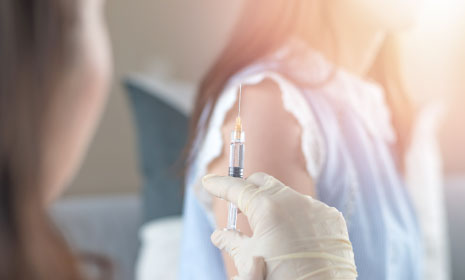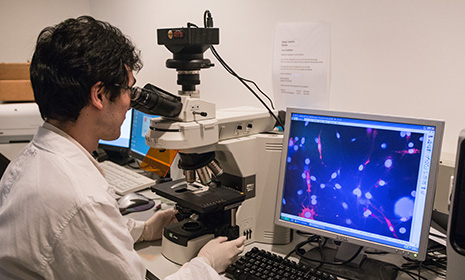HKUMed researchers studied the modes of transmission of novel coronavirus (SARS-CoV-2) and discovered a mechanism that may explain the temporary loss of sense of smell by using a golden hamster animal model
Researchers at the School of Public Health and the Department of Pathology, LKS Faculty of Medicine of the University of Hong Kong (HKUMed) used golden hamsters to study SARS-CoV-2 pathogenesis and transmission. The study shows that SARS-CoV-2 infection in golden hamsters resembles that found in humans with mild COVID-19 symptoms, and that the infected animals can efficiently transmit the disease to other hamsters by direct contact or through the air. This study not onlydemonstrates that this animal model may be useful in future studies of the effectiveness of vaccines and drugs to fight novel coronavirus, but is also the first study among research teams worldwide to make use of an animal model to study virus-mediated damage of the olfactory epithelium and neurons needed for the sense of smell in humans, providing a possible explanation of the temporary loss of olfactory senses in some of the infected patients. The findings are now published in Nature [link to the publication].
In the study, Dr Yen Hui-ling, Associate Professor of School of Public Health, HKUMed and her research team performed a series of experiments at a Biological Safety Level-3 laboratory, an essential core facility of HKUMed that supports the Faculty’s rapid response against the ongoing SARS-CoV-2 pandemic. They found that SARS-CoV-2 replicated in the respiratory and intestinal tracts of golden hamsters, leading to apparent weight loss and pneumonia. In addition to infecting nasal epithelial cells, SARS-CoV-2 appeared to infect olfactory sensory neurons in the nasal mucosa, which may explain the loss of smell reported in coronavirus patients. This damage appeared to be temporary and was followed by rapid tissue repair. In terms of transmission, SARS-CoV-2 was transmitted efficiently from the inoculated hamsters to naïve hamsters by direct contact or through the air. Transmission via contaminated cages (the fomite route) was less efficient. This animal model may be useful to study the effect of interventions (drugs, vaccines) on novel coronavirus as well as its transmission.
From the inoculated hamsters, viral RNA was continuously detected in the nasal washes or feces for at least 14 days, but infectious virus can only be detected for 6 days. The research team confirmed that the communicable period that an inoculated hamster may transmit the disease to another hamster was less than 6 days, which correlated with the detection of infectious virus by culture rather than detection of virus RNA by RT-PCR.Thus, even though virus RNA may be detected for many weeks in infected animals (and patients), these findings suggest that hamsters (and perhaps patients) are unlikely to be infectious after the first week upon the onset of illness (by which time infectious virus cannot be isolated by culture).
“Our findings support the recent changes in the criteria used in Hong Kong for discharge of COVID-19 patients from hospital isolation,” said Dr Yen. “The viral damage to the nasal epithelium and neurons associated with the sense of smell may not only explain the mechanism of the loss of sense of smell reported by infected patients, but also shows that, at least in the animal model, the damage is not likely to be permanent,” added Professor John Nicholls, Clinical Professor, Department of Pathology, HKUMed.
About the research team
The research was conducted by a team led by Dr Yen Hui-ling, Associate Professor, School of Public Health, HKUMed. Members of the research team included Professor Leo Poon Lit-man, Professor and Head of Division of Public Health Laboratory Sciences, School of Public Health, HKUMed; Professor Malik Peiris, Tam Wah-Ching Professor in Medical Science and Chair Professor of Virology, School of Public Health, HKUMed; and Professor John Nicholls, Clinical Professor, Department of Pathology, HKUMed.
The project was supported by the US National Institute of Allergy and Infectious Diseases (NIAID) under Centers of Excellence for Influenza Research and Surveillance (CEIRS) contract no. HHSN272201400006C, the Theme Based Research Scheme (Ref: T11-705/14N) of the Research Grants Council under University Grants Council, Government of Hong Kong Special Administrative Region.
About the School of Public Health, HKUMed
The School of Public Health, LKS Faculty of Medicine of The University of Hong Kong has a long and distinguished history in public health education and high impact research. With world leading research in infectious diseases as well as on non-communicable diseases of both local and global importance, the School has made significant contributions through its research and advocacy to improve the health of populations and individuals, both locally and globally. The School is a leading research and teaching hub in public health on influenza and other emerging viruses, control of non-communicable and infectious diseases, tobacco control, air pollution, psycho-oncology, behavioural sciences, exercise science, life-course epidemiology, and health economics, health services planning and management. This work has informed international (e.g. the US Food and Drug Administration, Health Canada, the World Health Organization), national and local public health policies.
For the latest update from HKUMed on COVID-19:
http://www.med.hku.hk/en/covid-19








.png)
